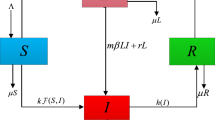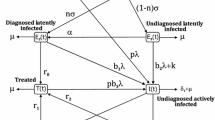Abstract
This paper proposes and analyzes a five-dimensional tuberculosis model incorporating slow-fast progression, endogenous reactivation, exogenous reinfection, and the assumption that infectives pass the smear microscopy test. This study disseminates information regarding how the presence and infectiousness of smear-negative patients in a tuberculosis epidemic significantly affect the threshold epidemic quantity \({\mathcal {R}_0}\) (basic reproduction number). Stability and bifurcation analysis is carried out, and we find that the exogenous reinfection causes backward bifurcation and multiple endemic steady states in the system. We analytically and numerically explored the case of the periodic oscillations in the population via Hopf bifurcation for \({\mathcal {R}_0<1}\) as well as \({\mathcal {R}_0>1}.\)













Similar content being viewed by others
Data availability
Our Manuscript has no associated data.
References
WHO.: The End TB Strategy. Aug 16, 2015. https://www.who.int/publications/i/item/WHO-HTM-TB-2015.19 (2015)
WHO.: Global tuberculosis report. 2021. https://apps.who.int/iris/handle/10665/346387 (2021)
Chadha, V.K.: Tuberculosis epidemiology in India: a review. Int. J. Tuberc. Lung Dis. 9(10), 1072–1082 (2005)
Lillebaek, T., Dirksen, A., Baess, I., Strunge, B., Thomsen, V.Ø., Andersen, Å.B.: Molecular evidence of endogenous reactivation of mycobacterium tuberculosis after 33 years of latent infection. J. Infect. Dis. 185(3), 401–404 (2002)
Blower, S.M., Mclean, A.R., Porco, T.C., Small, P.M., Hopewell, P.C., Sanchez, M.A., Moss, A.R.: The intrinsic transmission dynamics of tuberculosis epidemics. Nat. Med. 1(8), 815–821 (1995)
Das, D.K., Khajanchi, S., Kar, T.: Transmission dynamics of tuberculosis with multiple re-infections. Chaos Solitons Fractals 130, 109450 (2020)
Das, D.K., Kar, T.: Global dynamics of a tuberculosis model with sensitivity of the smear microscopy. Chaos Solitons Fractals 146, 110879 (2021)
Feng, Z., Castillo-Chavez, C., Capurro, A.F.: A model for tuberculosis with exogenous reinfection. Theor. Popul. Biol. 57(3), 235–247 (2000)
Lipsitch, M., Murray, M.B.: Multiple equilibria: tuberculosis transmission require unrealistic assumptions. Theor. Popul. Biol. 2(63), 169–170 (2003)
Sharomi, O.Y., Safi, M.A., Gumel, A.B., Gerberry, D.J.: Exogenous re-infection does not always cause backward bifurcation in TB transmission dynamics. Appl. Math. Comput. 298, 322–335 (2017)
Gerberry, D.J.: Practical aspects of backward bifurcation in a mathematical model for tuberculosis. J. Theor. Biol. 388, 15–36 (2016)
Athithan, S., Ghosh, M.: Mathematical modelling of TB with the effects of case detection and treatment. Int. J. Dyn. Control 1, 223–230 (2013)
Huo, H.-F., Zou, M.-X.: Modelling effects of treatment at home on tuberculosis transmission dynamics. Appl. Math. Model. 40(21–22), 9474–9484 (2016)
Mushayabasa, S., Bhunu, C.: Modeling the impact of early therapy for latent tuberculosis patients and its optimal control analysis. J. Biol. Phys. 39, 723–747 (2013)
Sun, C., Yang, W.: Global results for an sirs model with vaccination and isolation. Nonlinear Anal. Real World Appl. 11(5), 4223–4237 (2010)
Egonmwan, A., Okuonghae, D.: Analysis of a mathematical model for tuberculosis with diagnosis. J. Appl. Math. Comput. 59, 129–162 (2019)
Okuonghae, D., Korobeinikov, A.: Dynamics of tuberculosis: the effect of direct observation therapy strategy (dots) in Nigeria. Math. Model. Nat. Phenomena 2(1), 113–128 (2007)
Moualeu, D., Yakam, A.N., Bowong, S., Temgoua, A.: Analysis of a tuberculosis model with undetected and lost-sight cases. Commun. Nonlinear Sci. Numer. Simul. 41, 48–63 (2016)
Desikan, P.: Sputum smear microscopy in tuberculosis: is it still relevant? Indian J. Med. Res. 137(3), 442 (2013)
Linguissi, L.S.G., Vouvoungui, C.J., Poulain, P., Essassa, G.B., Kwedi, S., Ntoumi, F.: Diagnosis of smear-negative pulmonary tuberculosis based on clinical signs in the Republic of Congo. BMC Res. Notes 8, 1–7 (2015)
Hernandez-Garduno, E., Cook, V., Kunimoto, D., Elwood, R., Black, W., FitzGerald, J.: Transmission of tuberculosis from smear negative patients: a molecular epidemiology study. Thorax 59(4), 286–290 (2004)
Campos, L.C., Rocha, M.V.V., Willers, D.M.C., Silva, D.R.: Characteristics of patients with smear-negative pulmonary tuberculosis (TB) in a region with high TB and HIV prevalence. PLoS ONE 11(1), 0147933 (2016)
Pandey, S., Chadha, V., Laxminarayan, R., Arinaminpathy, N.: Estimating tuberculosis incidence from primary survey data: a mathematical modeling approach. Int. J. Tuberc. Lung Dis. 21(4), 366–374 (2017)
Van den Driessche, P., Watmough, J.: Reproduction numbers and sub-threshold endemic equilibria for compartmental models of disease transmission. Math. Biosci. 180(1–2), 29–48 (2002)
Chitnis, N., Hyman, J.M., Cushing, J.M.: Determining important parameters in the spread of malaria through the sensitivity analysis of a mathematical model. Bull. Math. Biol. 70(5), 1272–1296 (2008)
Castillo, C., Feng, Z., Huang, W.: On the computation of R0 and its role on global stability. In: Mathematical Approaches for Emerging and Reemerging Infectious Diseases: An Introduction (Minneapolis, MN, 1999), pp. 229–250 (2002)
Li, M.Y., Muldowney, J.S.: A geometric approach to global-stability problems. SIAM J. Math. Anal. 27(4), 1070–1083 (1996)
Coppel, W.A.: Stability and Asymptotic Behavior of Differential Equations: Heath (1965)
Muldowney, J.S.: Compound matrices and ordinary differential equations. Rocky Mt. J. Math. 20, 857–872 (1990)
Freedman, H.I., Ruan, S., Tang, M.: Uniform persistence and flows near a closed positively invariant set. J. Dyn. Differ. Equ. 6(4), 583–600 (1994)
Castillo-Chavez, C., Song, B.: Dynamical models of tuberculosis and their applications. Math. Biosci. Eng. 1(2), 361 (2004)
Perko, L.: Differential Equations and Dynamical Systems. Springer, Berlin (2013)
Liu, W.-M.: Criterion of hopf bifurcations without using eigenvalues. J. Math. Anal. Appl. 182(1), 250–256 (1994)
Acknowledgements
AS acknowledges financial support by the Indian Institute of Technology Patna. Authors are grateful to the anonymous referees for their constructive suggestions which has significantly improved the manuscript and its presentation.
Author information
Authors and Affiliations
Corresponding author
Ethics declarations
Conflict of interest
The authors declare that they have no conflict of interest.
Additional information
Publisher's Note
Springer Nature remains neutral with regard to jurisdictional claims in published maps and institutional affiliations.
Rights and permissions
Springer Nature or its licensor (e.g. a society or other partner) holds exclusive rights to this article under a publishing agreement with the author(s) or other rightsholder(s); author self-archiving of the accepted manuscript version of this article is solely governed by the terms of such publishing agreement and applicable law.
About this article
Cite this article
Srivastava, A., Srivastava, P.K. A tuberculosis model with the impact of sputum smear microscopy. J. Appl. Math. Comput. 70, 711–740 (2024). https://doi.org/10.1007/s12190-023-01984-3
Received:
Revised:
Accepted:
Published:
Issue Date:
DOI: https://doi.org/10.1007/s12190-023-01984-3




